How do wear facets occur, and how to deal with them?
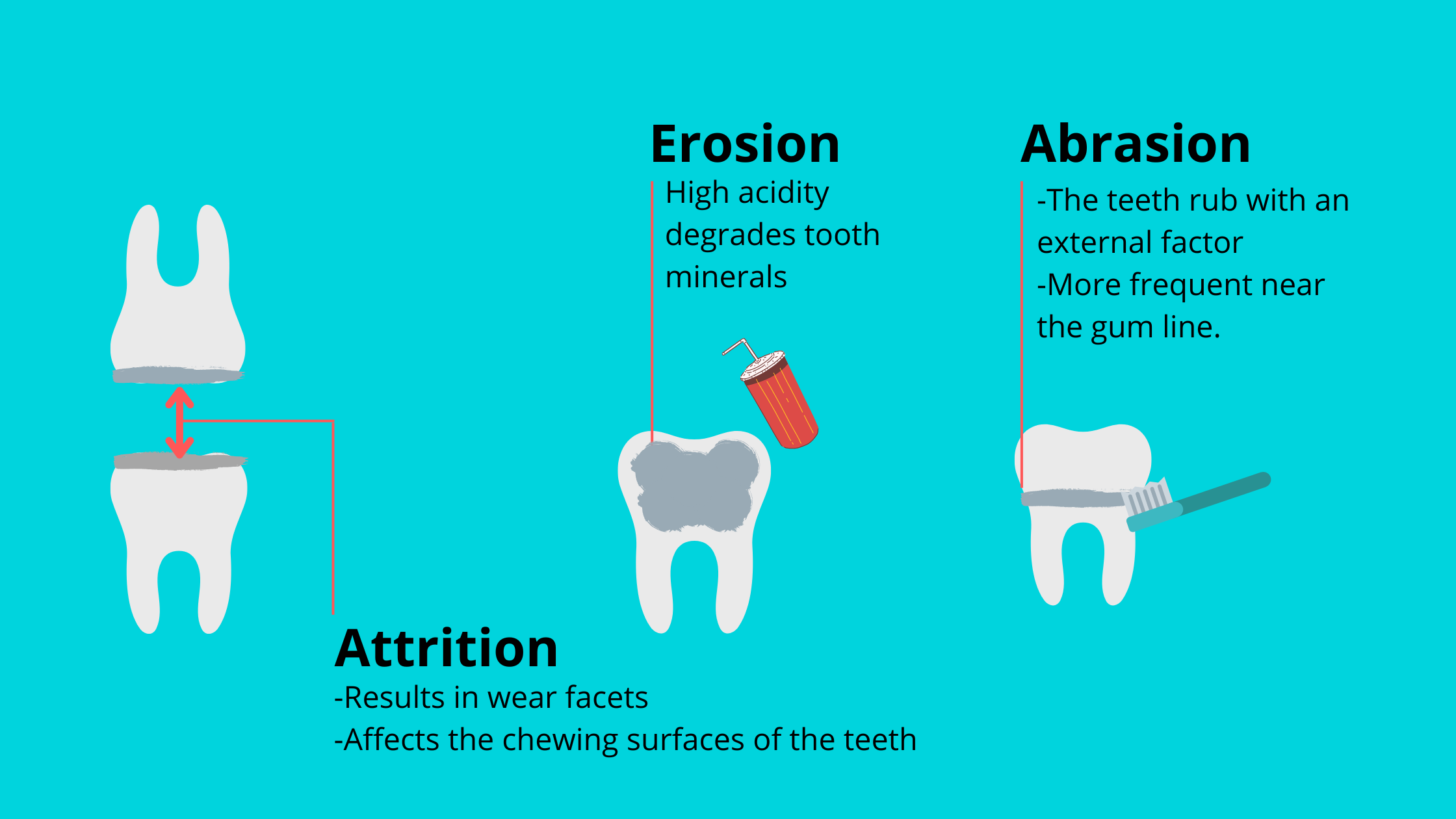 Did you know that tooth decay is not the only thing that can damage our teeth?
Did you know that tooth decay is not the only thing that can damage our teeth?
There's also something called non-carious lesions, and one of the most common types is tooth wear.
When teeth rub against each other too much, the enamel can break down and create flat, shiny, polished surfaces on our teeth - known as wear facets.
These can come in different shapes and sizes depending on the associated factors, but they all have one thing in common — too much contact between the teeth.
Keep reading to learn more about how wear facets occur and what you can do to deal with them.
In this article:
1. How do wear facets appear?
2. How can wear facets progress?
3. Other forms of tooth wear
4. Treatment of wear facets
How do wear facets appear?
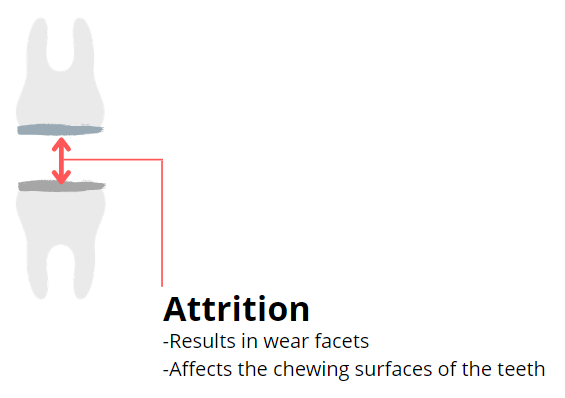 Our teeth wear down over time.
Our teeth wear down over time.
It’s a natural and slow process that happens with age as we use our teeth for chewing and other normal oral functions.
The problem begins when we use our teeth outside of these normal functions, without any real reason. This is known as parafunctional habits.
Parafunctional habits include things like biting on hard objects, grinding, and clenching the teeth — also known as bruxism.
These habits often happen subconsciously, so you might not even realize you're constantly damaging your teeth.
When teeth wear down due to repeated contact between the upper and lower teeth — like during clenching or grinding — it's called attrition.
One of the signs of attrition is the presence of smooth, flat, and shiny areas on the chewing surfaces of your teeth, known as wear facets.
When you bite down, these wear facets on the upper and lower teeth fit together perfectly — a clear sign that the damage is caused by attrition.
Unlike the natural wear that comes with aging, attrition is more aggressive and can damage your teeth much faster.
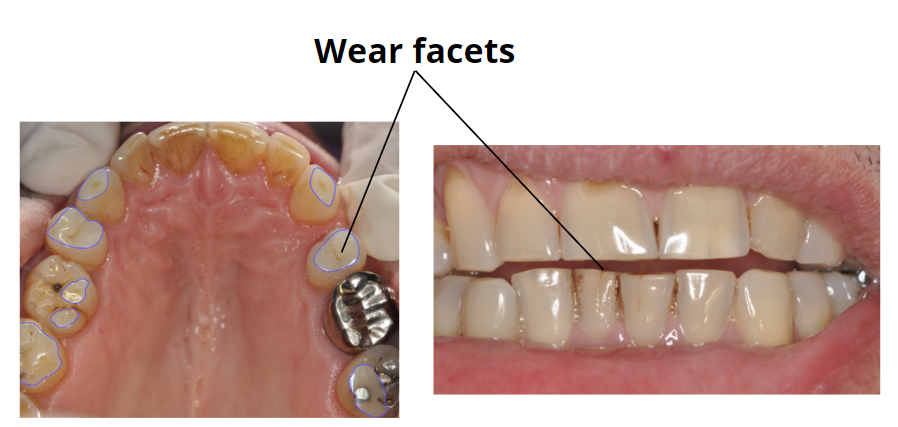
How can wear facets progress?
If wear facets aren’t treated early, they can worsen until more than half of the tooth is worn away. This often leads to tooth sensitivity, causing sharp pain when eating hot, cold, or sweet foods.As the wear progresses, everyday functions like chewing, swallowing, and speaking can become more difficult due to the loss of tooth structure.
If the front teeth are affected, it may also change the appearance of your smile. But it doesn't stop there — if the damage involves the back teeth, it can reduce your lower facial height and even alter your facial features.
That’s why it’s important to address wear facets early before they get worse and become much more difficult to manage.
Other forms of tooth wear
Aside from wear facets caused by attrition, there are other types of tooth wear that can also create smooth, shiny, worn-down surfaces.Unlike attrition, these forms of wear aren’t caused by teeth grinding against each other, but by external factors.
This includes brushing too hard with a stiff toothbrush, using abrasive toothpaste, biting on hard objects like pens or nails, and consuming acidic foods or drinks.
When tooth wear is caused by mechanical forces from hard objects, it’s called abrasion. When it’s due to acids wearing away the enamel, it’s called erosion.
Both can seriously damage your teeth if left unchecked.
1. Erosion:
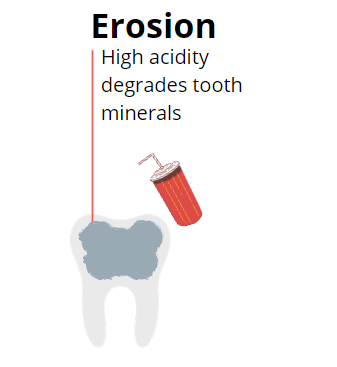 This type of wear is caused by a chemical process.
This type of wear is caused by a chemical process.
It occurs when teeth are frequently exposed to acidic substances that strip away their minerals.
The enamel — the outermost layer of the tooth — can break down quickly depending on how acidic the substance is and how long the exposure lasts.
This can create smooth, worn areas that may resemble wear facets.
Unlike attrition, erosion can affect all sides of the tooth — not just the chewing surfaces.
Causes:
- Frequent acid reflux or repeated vomiting
- Overconsumption of soda, citrus fruits, and other acidic drinks
- Low saliva flow or dry mouth
- Taking acidic medications or supplements, such as vitamin C or aspirin
Treatment and prevention:
You can help prevent tooth erosion by drinking plenty of water throughout the day and rinsing your mouth with a baking soda solution to neutralize acids and reduce erosion.Also, choose a non-abrasive fluoride toothpaste and wait 30 minutes before brushing your teeth after a meal.
When erosion has reached the underlying teeth structures, veneers, crowns, or fillings may be considered to restore the function and appearance of the teeth.
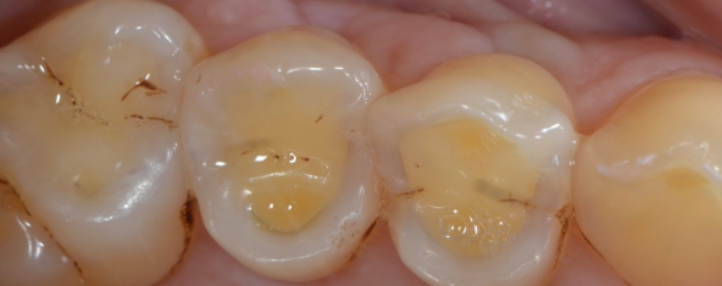
Wear facets due to erosion
2. Abrasion:
 In abrasion, the friction that causes wear comes from a harsh external object, like an abrasive toothpaste or a hard bristle toothbrush.
In abrasion, the friction that causes wear comes from a harsh external object, like an abrasive toothpaste or a hard bristle toothbrush.
This repeated contact can break down the hard tissue of the tooth and cause visible damage.
Abrasion often affects the upper teeth, especially the canines and molars.
The damage often appears near the gum line as a deep, V-shaped notch that is easy to spot.
Causes:
- Overusing toothpicks.
- Aggressive brushing with a hard toothbrush and abrasive toothpaste.
- Harmful habits such as biting the nails or cracking seeds or a hard object between the teeth.
Treatment and prevention:
To prevent this type of injury, you should first brush your teeth with a soft-bristled toothbrush and a non-abrasive toothpaste. Avoid applying too much pressure or using horizontal strokes, as they are more aggressive to your teeth and gums.Treatment consists of removing the cause and restoring the lesions with fillings, crowns, or veneers.
3. Abfraction:
Abfraction is a type of wear that happens when the hard tissues of the tooth break down near the gum line due to excessive stress on its chewing surface.When the tooth receives a lot of pressure, it flexes and bends slightly. This concentrates the stress near the gum line and causes the enamel and dentin to break down.
The most common factors for abfraction are crowding and bruxism (tooth grinding).
Treatment of wear facets
The treatment of wear veneers depends on the extent of the damage and the teeth involved. It usually starts with removing the root cause. Once the risk factors are addressed, the damaged teeth can be restored. Treatment options include:- Mouthguard: Especially helpful if you grind your teeth subconsciously at night. It protects your teeth from further wear caused by this habit.
- Composite restoration: Tooth-colored material added to worn areas to restore the shape and function of damaged teeth.
- Inlay/Onlay: Ceramic, tooth-colored restorations bonded to the chewing surfaces of back teeth to replace lost structure.
- Dental veneers: Thin, highly cosmetic shells bonded to the front visible surfaces of teeth. They offer a more aesthetic option than composite fillings.
- Dental crowns: Caps placed over damaged teeth, recommended when more than half of the tooth is worn down.